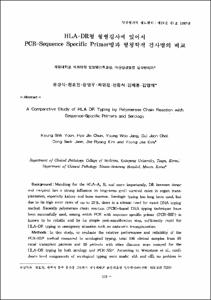KUMEL Repository
1. Journal Papers (연구논문)
1. School of Medicine (의과대학)
Dept. of Laboratory Medicine (진단검사의학)
HLA-DR형 형별검사에 있어서 PCR-Sequence Specific Primer법과 혈청학적 검사법의 비교
- Keimyung Author(s)
- Jeon, Dong Seok; Chun, Hyo Jin; Kim, Jae Ryong
- Department
- Dept. of Laboratory Medicine (진단검사의학)
- Journal Title
- 임상검사와 정도관리
- Issued Date
- 1997
- Volume
- 19
- Issue
- 1
- Keyword
- PCR-SSP; HLA-DR typing, Transplantation
- Abstract
- Background : Matching for the HLA-A, B, and more importantly, DR between donor and recipient has a strong influence on long-term graft survival rates in organ transplantation, especially kidney and bone marrow. Serologic typing has long been used, but due to its high error rates of up to 25%, there is a clinical need for exact DNA typing method. Recently polymerase chain reaction (PCR)-based DNA typing techniques have been successfully used, among which PCR with sequence specific primer (PCR-SSP) is known to be reliable and by its simple post-amplification step, sufficiently rapid for HLA-DR typing in emergency situation such as cadaveric transplantation.
Methods : In this study, to evaluate the relative performance and reliability of the PCR-SSP method compared to serological typing, total 100 clinical samples from 85 renal transplant patients and 15 patients with other diseases were assayed for the HLA-DR typing by both serology and PCR-SSP. According to Wetzsteon et al., confidence level assignments of serological typing were made: clA and clB, no problem in assignment; clC and clD, difficult in assignment. Fifteen B-lymphoblastoid cell lines were used as a source of reference DNA to confirm the specificity of PCR-SSP.
Results : All the amplification patterns using cell lines were easy to interpret and identical to the expected patterns. In serological typing using clinical samples, 60.0% were assigned as clA and clB and 40.0% were assigned as clC and clD, and there were 29(29.0%) discrepancies in HLA-DR typing between serology and PCR-SSP. Of these, four(13.8%)were serological failure; 18(62.0%) assignments of other alleles by PCR-SSP to serological "blank"; four(13.8%) differently assigned by serology and PCR-SSP ; three(10.3%) allele splits not assignable by serology. But there was no sin\-gle case of PCR-SSP failure.
Conclusions : HLA-DR typing by the PCR-SSP technique, especially a rapid modfied method of PCR-SSP, is ideally suited for analyzing small number of samples simultaneously and is an alternative to serological typing in routine clinical practice including donor-recipient matching in cadaveric transplantations.
배경 : 장기이식 특히 신이식과 골수이식에 있어서는 장기공여자와 수용자 사이에 조직적합성 특히 HLA-DR형의 적합 정도가 이식의 성공여부를 결정하는 중요한 인자로 알려져 있다. 혈청학적인 방법에 의한 HLA-DR형 검사는 결과의 신뢰성이 낮아 새로운 검사방법이 모색되고 있다. 최근 분자생물학적 기법의 발전으로 PCR을 이용한 여러 가지 변법이 시도되었으며 이중 PCR-SSP법이 신속하면서도 결과의 판독이 쉬워 임상적 유용성 이 높은 것으로 알려져 있다.
방법 : 신이식을 위하여 HLA 형별검사가 의뢰 된 85명과 기타 질환군 환자 15명 등 총 100명의 환자로부터 얻은 말초혈액을 검체로 하여 종래의 혈청학적 방법과 PCR-SSP법으로 HLA-DR형 검사를 실시하여 그 결과를 비교하고,15개의 B 림프구 세포주를 이용하여 PCR-SSP의 특이성을 확인하였다.
결과 : 대상검체중 혈청학적방법으로 HLA-DR 검사결과 판독에 무리가 없었던 신뢰도 둥급 clA와 clB가 60.0%였으며, 판독이 곤란하였던 신뢰도 둥급 clC와 clD가 40.0%였다. 세포주를 이용한 PCR-SSP법의 특이도를 조사한 결과 모든 세포주에서 예상하였던 특이 band의 증폭을 관찰할 수 있었으며, 임상검체를 이용한 검사결과에서도 모든 예에서 명확한 band가 증폭되어 HLA-DR형 판정이 용이하였다. 혈청학적 방법과 PCR-SSP법 간의 HLA-DR형 판정이 불일치된 경우는 모두 29예(29.0%)였다. 불일치된 예의 유형은 혈청학적 방법상 HLA-DR형 판정(13.8%)이나, split형 판정(10.3%)이 불가능하였던 경우, 혹은 혈청학적 검사상 동형접합체(흑은 blank)였으나 PCR-SSP법으로 이형접합체로 판정된 경우(62.0%)와 혈청학적 방법과 PCR-SSP법에 의한 HLA-DR형 판정이 서로 다른 경우(13.8%) 등이었으며, PCR-SSP의 판정이 곤란하였던 경우는 한 예도 없었다. 신속 PCR-SSP법으로 임상검체 20예와 세포주로서 시험한 결과 모두 통상적인 PCR-SSP법과 그 결과가 일치하였으며, 검사 소요시간은 2시간이었다.
결론 : 이상의 결과로 PCR-SSP법에 의한 HLA-DR형 검사는 B형 림프구의 분리가 필요없이 소량의 검체로도 신속 정확한 검사가 가능하여 응급상황에서 이루어지는 뇌사자 장기이식에 특히 유용할 것으로 생각되며, 앞으로 경제성이 높고 검사수기가 간단한 HLA-DR형 검사용 PCR-SSP kit의 개발이 필요할 것으로 사료된다.
- Alternative Title
- A Comparative Study of HLA-DR Typing by Polymerase Chain Reaction with Sequence-Specific Primers and Serology
- Publisher
- School of Medicine
- Citation
- 윤경식 et al. (1997). HLA-DR형 형별검사에 있어서 PCR-Sequence Specific Primer법과 혈청학적 검사법의 비교. 임상검사와 정도관리, 19(1), 215–231.
- Type
- Article
- ISSN
- 1225-097X
- Appears in Collections:
- 1. School of Medicine (의과대학) > Dept. of Laboratory Medicine (진단검사의학)
- 파일 목록
-
-
Download
 oak-bbb-04906.pdf
기타 데이터 / 3.64 MB / Adobe PDF
oak-bbb-04906.pdf
기타 데이터 / 3.64 MB / Adobe PDF
-
Items in Repository are protected by copyright, with all rights reserved, unless otherwise indicated.